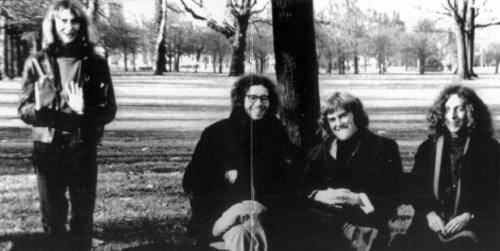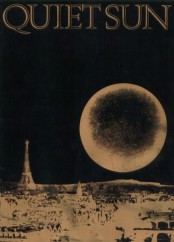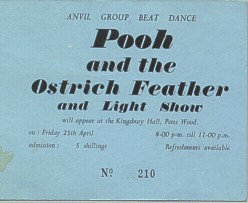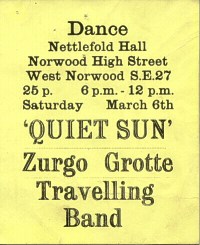
To hear Real Audio tracks of this album click here
To buy this album click here

Quiet Sun c. 1970. Left to right: Bill MacCormick, Phil Manzanera, Charles Hayward, Dave Jarrett

"Diamond Head", the recently-released and much-lauded solo debut by Roxy Music's toreador of the Telecaster PHIL MANZANERA, took 26 days between January and February of this year. Which means it was 'on time' - a rare occurrence in this present era. Slightly more remarkable is the fact that Manzanera managed to record a second album at the same sessions: "Mainstream" - a complex and intense performance by a group called QUIET SUN. Thus, the work-o-meter swung up to "very fast" and a lot of the environmental hysteria suppressed and channelled so cunningly by Senor Manzanera in the majestic "Diamond Head" burst out during the urgent, clock-watching, early-hours takes for "Mainstream".
Hot, dark, manic, and electrifying, "Mainstream" stands smouldering in the debris of a multiple collision between elements of Lifetime, The Soft Machine The Velvet Underground, and a stray nuclear warhead. Beyond a shared use of vivid colour and high-voltage execution, "Mainstream" seems to have little in common with its sister album, "Diamond Head" herself. But look closer (and roll credits . . . ):
PHIL MANZANERA Guitars To those listeners unfamiliar with the freedom and ferocity of Phil's playing on "Alma" and "Miss Shapiro" ("Diamond Head"), his work on "Mainstream" will come as a shock. It ought not to. QUIET SUN is where Manzanera came from and his notable guitar contributions to Roxy favourites like "Ladytron", "The Bogus Man", "Serenade" "Mother Of Pearl", and "Prairie Rose" distil and concentrate a lyricism and power evolved in quite different musical circumstances.
Back in 1966 our boy was at school at Dulwich College, a large and fairly conventional public school in South London. Dreaming spires, green swards . . . and rock 'n' roll. The Beatles, Dylan and The Beach Boys were at their heights. The American West Coast was beginning to open up. The "alternative society" was beginning to make itself felt. Phil Manzanera was beginning to practise on an old Hofner Galaxie.
1967 was nice if you liked that sort of thing. At Dulwich College if you didn't like that sort of thing, you were either very boring or one of the teachers. With this premise in mind and a stack of import stuff by Zappa, Beefheart, Spirit and The Velvet Underground under his arm, Phil approached a chum of his, hereafter referred to as:

BILL MACCORMICK Bass
Later to play scintillating runs on a Fender Precision for the likes of Gong and Matching Mole, MacCormick at this time believed himself to be either a drummer or a vocalist. The group he formed with Manzanera - the long forgotten Pooh And The Ostrich Feather - believed him to be a vocalist too, and so he was. However, the drums were to be played by a volatile lad from the year below these two:
CHARLES HAYWARD Percussion
Charlie did a lot of screaming and playing his bizarre kit in a manner roughly equidistant between Andrew Cyrille and Keith Moon. He joined Manzanera and MacCormick in writing the band's earliest material, collaborating with Phil on a paean to famed surrealist Marcel Duchamps entitled "Marcel My Dada", the theme of which can be heard menacing the genial levity of "Frontera" on "Diamond Head".

For three years and with a constantly evolving line-up, Pooh And The Ostrich Feather were The Grateful Dead of Dulwich - a thankless task, as you can imagine. But inspiration was just around the corner in Dalmore Road, where lived Robert Wyatt and most of the contemporary Soft Machine. MacCormick became friends with Wyatt and stole all his licks. But in order to incorporate elements of The Soft Machine into a band which encored with Paul Butterfield's "Born In Chicago", certain members had to be liquidated. This was effected without mercy.
Manzanera, MacCormick, and Hayward conferred over a possible fourth recruitment in the wake of the 1970 putsch, and resolved that what they needed most desperately was somebody with a PhD in Mathematics. Consequently they ran through a list of 'Old Boys' of the school and came up with:
DAVE JARRETT Keyboards
The coincidence was too good to be true. With a will, the quartet got down to rehearsals - only to discover that they had no bass-player. Vocalist and drummer (failed) MacCormick conducted a series of auditions with bassists on leave from Victor Sylvester until losing his patience at 11.06 on March 3rd 1970 and taking up the troublesome instrument himself. Within three hours he had tuned the bottom E.

Within two years, QUIET SUN had accumulated the mass of complex and distinctive material which serves as source for both "Mainstream" and approximately half of "Diamond Head". At this point, it was decided to call a halt. Phil was spending a lot of time round at Bryan Ferry's house, pretending to operate a mixing console and tuning David O'List's guitars. Bill, having not recovered from the Portsmouth Poly jam between QUIET SUN and Robert Wyatt's Symbiosis, was hot for more and suggested to Wyatt that the bass-player he needed for Matching Mole need not necessarily be Charlie Mingus. Charles was flitting back and forth between Mal Dean's Amazing Band and David Allen's Gong, in the meantime writing songs that nobody could play - like "RongWrong" on "Mainstream". Dave, moreover, had a yen to lecture on quantum physics.
QUIET SUN ceased in 1972. . . . . . to resurface, three years later, on the HELP label with an album of material selected from their original set. Recording "Mainstream" was hell, although a good time was had by one and all in strict accordance with studio etiquette. The group had time for only two brief rehearsals and most of the basic tracks on the finished album are first-takes. It sounds hectic, and it was.

But worse than this was the fact that "Diamond Head" was being recorded in the same place at the same time. Special observers were brought in to make sure that parts of one album did not defect to the other - a task made more herculean by the fact that not only were "Diamond Head" and "Mainstream" the first twins born in a London studio, but they also shared many musical features. For example: "Mainstream" opens with Engineer Rhett Davies' "live" cue-in, followed by "Sol Caliente". The tune being played on echoplexed fuzz guitar might strike fans of "Diamond Head's" "Lagrima" as familiar. In fact, "Lagrima", "Frontera", "East Of Echo", and "Alma" all derive from one extended QUIET SUN composition - Phil Manzanera's "Corazon Y Alma" ("Heart And Soul") - written in late 1971. Less obvious is the similarity of the 5/4 bass riff from "Same Time Next Week" and what's happening behind Manzenera's savage outburst on Track Two, Side Two of "Mainstream" - "Trot", vintage 1970. Indeed, if you listen to "East Of Echo", you encounter three or four QUIET SUN references now placed in their original context by "Mainstream". The two records co-relate, in other words. In their duality they illuminate each other. Quick - buy both. You know it makes sense.

Back to Quiet Sun Mainpage
